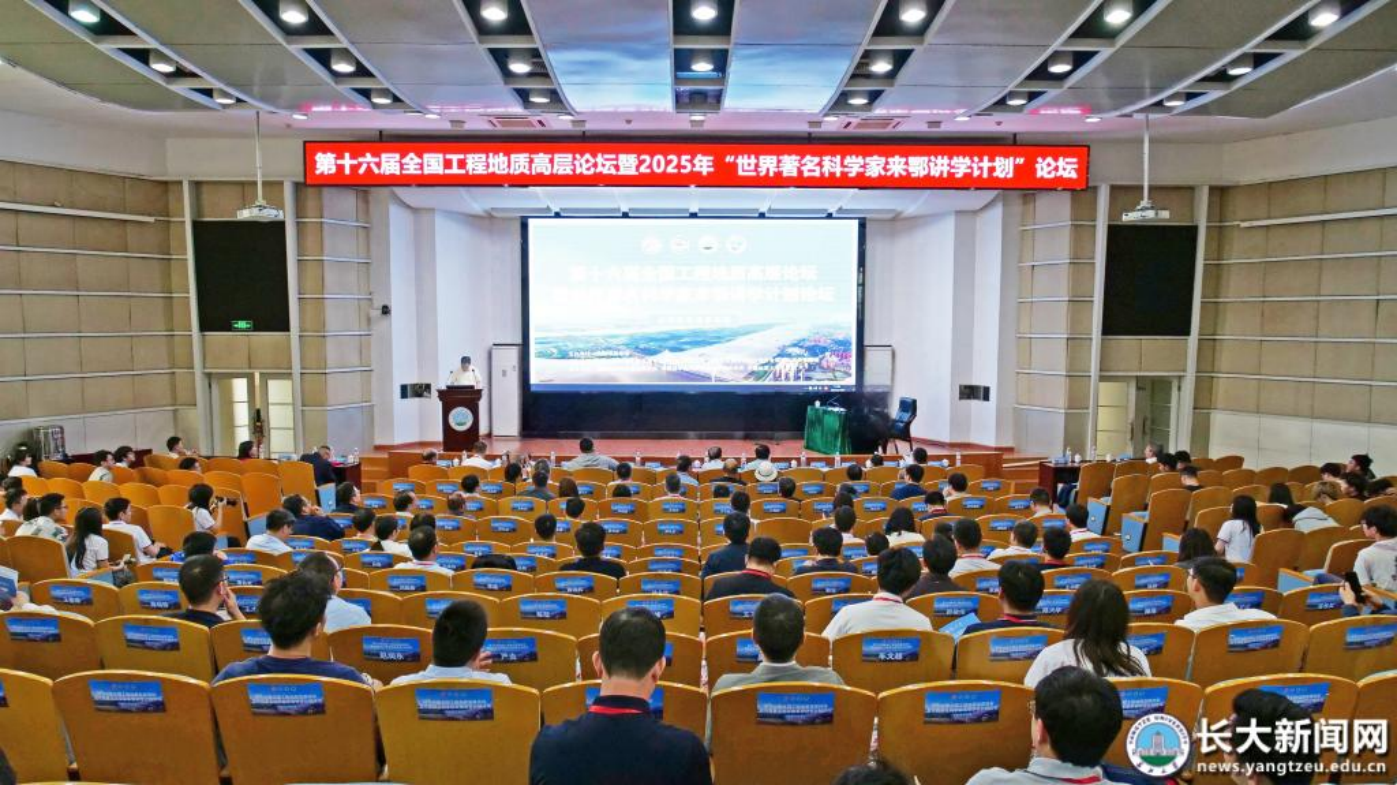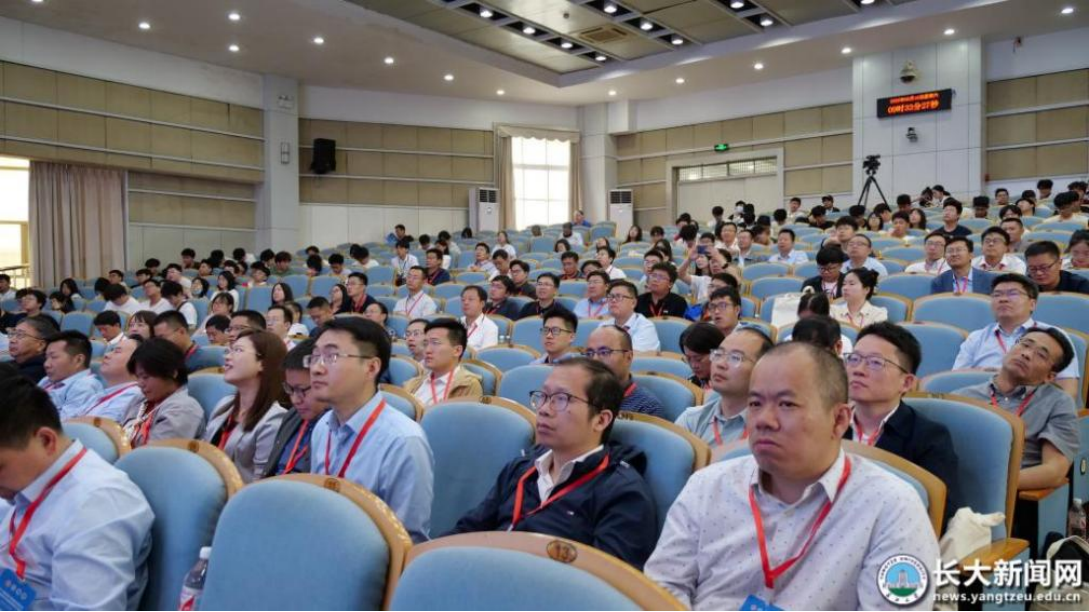On May 10, The 16th National High-Level Forum on Engineering Geology and The 2025 Forum of “World Renowned Scientists Lecture Program in Hubei” was held at the East Campus of Yangtze University. More than 150 experts and scholars from over 50 universities and research institutes across China and abroad gathered in the ancient city of Jingzhou, including Academicians from the Chinese Academy of Sciences, the U.S. National Academy of Engineering, and the Russian Academy of Engineering and Natural Sciences. Centering on the theme of “Global Change and Multiple Hazards”, the participants discussed the latest frontier developments in the field of engineering geology, contributing intellectual power to addressing climate change and geological disaster mitigation. The opening ceremony was hosted by Vice President Jiang Houshun.

Zhang Huichang, Director of the Geological Exploration Management Division at the Ministry of Natural Resources, stated in his opening remarks that in recent years, frequent extreme heavy rainfall events in China have triggered numerous complex chain disasters, posing challenges to disaster prevention and mitigation management as well as scientific research. He noted that this forum focused on advancing ecological civilization construction and modernizing disaster prevention and mitigation systems. He expressed his hope that everyone would “focus on new issues, pay attention to new challenges, and value minor problems”, working together to meet the challenges posed by global climate change, empowering prevention of geological disasters through scientific and technological innovation, safeguarding the lives and property of the people, and contributing to the building of a beautiful China.

Wang Jianping, Party Secretary of Yangtze University, emphasized that the discipline of geology at Yangtze University aligns with national strategic imperatives and local socioeconomic development needs. The discipline has conducted in-depth research centering on geological resources, climate hydrology, environmental ecology, safety of oil&gas pipeline and other fields, achieving a series of results in prevention and control of geological disasters. He expressed the hope that this forum would serve as an opportunity to spark more intellectual inspiration and innovative achievements, bringing new ideas and opening up new pathways for academic research in engineering geology.

Tang Huiming, Chairman of the Engineering Geology Committee of Chinese Society for Geology, Academician of the Russian Academy of Engineering and Natural Sciences, and Chief Professor of Geological Engineering at China University of Geosciences (CUG), highlighted that global climate change is reshaping geohazard distribution patterns and occurrence mechanisms. He proposed enhancing academic exchanges to inspire theoretical innovation, deepening the understanding of multi-hazard verification mechanisms, and advancing breakthroughs in AI-powered remote sensing monitoring technologies. These efforts aim to provide scientific solutions for addressing global change challenges, and to jointly drive the innovative development of China’s engineering geology discipline.

Professor Chen Ningsheng, Executive Vice Chair of the Forum Organizing Committee, expressed his hope that the forum will deepen the understanding of multi-hazard developmental mechanisms under global climate change, advance disaster mitigation theories and technological innovations, and establish new key research directions in the field of engineering geology.

Six invited keynote reports delved into cutting-edge advancements and applied practices following the opening ceremony, igniting a surge of academic engagement.
• Soroosh Sorooshian, member of the U.S. National Academy of Engineering (NAE), foreign Academician of the Chinese Academy of Sciences, and recipient of international honors including the IEEE Lifetime Achievement Award, inaugurated the session with insights into three core elements of hydrometeorological modeling. Drawing on three decades of his expertise, he systematically analyzed observational technologies and application innovations.
• Peng Jianbing, Academician of the Chinese Academy of Sciences, professor at Chang’an University and China University of Geosciences Beijing(CUGB), and a leading figure in China’s engineering geology and geohazard studies, elucidated synergistic pathways for ecological conservation and disaster mitigation through case studies of eco-geology of Qinling Mountain.
• Prof. Duan Qingyun from Hehai University, fellow of the American Meteorological Society, demonstrated groundbreaking applications of hybrid optimization algorithms in environmental engineering via non-point source water pollution studies in the Four-Lake Watershed in the hinterland of the Jianghan Plain in central Hubei Province, China.
• Prof. Chen Ningsheng from the host university deciphered geohazard attributes, triggering mechanisms, and prediction models based on drought and seismic precursors.
• Prof. Guo Feng from the host university uncovered genetic linkages between South China granites and geohazard.
• Prof. Jin Jiming from the host university shared landslide prediction methodologies leveraging global rainfall and terrestrial water storage data models.
These frontier-aligned advancements addressing geological security imperatives sparked heated discussions among participants.

The afternoon’s “Emerging Scholars Lightning Talks” session proved equally riveting. Ten rising stars in engineering geology showcased cutting-edge research advancements from their teams, focusing on climate change and multiple hazards, eco-environmental evolution and multiple hazards in the multi-hazard Qinba Mountain region, as well as multi-hazard identification, prediction, and early warning, demonstrating strong innovative vitality. Their presentations radiated intellectual vibrancy in tackling frontier challenges. Live discussions surged as scholars engaged in vigorous debates, dissecting methodological bottlenecks and implementation challenges encountered in current research paradigms, exploring synergistic intersections in the future, and sparking innovative conceptual breakthroughs.

On May 11, scholars conducted field investigations of the Jianghan Plain’s geomorphology, the Jingjiang levee, and protective engineering structures of Jingzhou Ancient City. The discussions centered on the engineering wisdom embodied in the flood control system along the Jingjiang segment and geotechnical applications in preservation of historic walls, providing empirical cases for synergizing disaster mitigation theories with practical engineering solutions.

This forum was convened by the China Geological Society, and jointly organized by the Engineering Geology Committee of the China Geological Society, Yangtze University, and the International Science and Technology Cooperation Center for Mountain Multi-Hazard Prevention and Engineering Safety. Over 250 related faculty and students from relevant disciplines at Yangtze University participated in the academic exchanges.